Investigations of Performance of Mini-Channel Condensers and Evaporators for Propane
Abstract
1. Introduction
2. Test Stand and Methodology
3. Results
3.1. Investigations of Mini-Channel Condenser
3.2. Investigations of Mini-Channel Evaporator
4. Conclusions
- The stable operation of the tested mini-channel heat exchanger as an evaporator was proved. No instabilities of operation of this heat exchanger were observed that could result in the deterioration of heat transfer under the conditions of operation with a changed mass flow rate or vapour superheating at the outlet of the evaporator.
- The investigation results confirmed there is an increase in the mean heat transfer coefficient alongside the increase in the refrigerant mass flow rate for the tested mini-channel condenser and evaporator. It should be also taken into account that the heat transfer coefficient was averaged and refers to the entire heat exchanger, which covers the liquid subcooling region (in the condenser) as well as the vapour superheating region (in the evaporator).
- Liquid subcooling causes a significant increase in both the overall and surface heat transfer coefficients for the tested mini-channel condenser; an increase in liquid subcooling from 3–4 K up to 15 K causes a twofold increase in the overall heat transfer coefficient and approx. a triple increase in the surface heat transfer coefficient.
- The vapour superheating at the outlet of the tested mini-channel evaporator causes a significant reduction in the surface heat transfer coefficient, i.e., a change in the vapour superheating from 3 K to 15 K causes approx. a 60% reduction in the surface heat transfer coefficient.
- The modified Müller-Steinhagen pressure-drop correlation may be effectively applied for calculation of the frictional pressure drop in the tested mini-channel condenser and evaporator. We proposed our own correlations for the friction coefficient for the propane mini-channel condenser and evaporator.
- There is a clear need for further research on the thermal performance of the mini-channel condensers and evaporators of different geometries and flow configurations in order to establish an experimentally based methodology of prediction for average heat transfer coefficients, especially with propane as a working fluid.
Author Contributions
Funding
Data Availability Statement
Conflicts of Interest
References
- Cavallini, A.; Del Col, D.; Rossetto, L. Heat transfer and pressure drop of natural refrigerants in minichannels (low charge equipment). Int. J. Refrig. 2013, 36, 287–300. [Google Scholar] [CrossRef]
- Del Col, D.; Bortolato, M.; Bortolin, S. Comprehensive experimental investigation of two-phase heat transfer and pressure drop with propane in a minichannel. Int. J. Refrig. 2014, 47, 66–84. [Google Scholar] [CrossRef]
- Bhosale, S.; Acharya, A.R. Review on Applications of Micro Channel Heat Exchanger. Int. Res. J. Eng. Technol. 2020, 7, 5326–5329. [Google Scholar]
- Sanap, O.; Kulkarni, P.; Holkar, S.; Chaudhari, P.; Dholkawala, M.S. Heat Enhancement in Mini Channel Heat Exchanger using Software Analysis Method. Int. J. Eng. Res. Appl. 2020, 10, 1–7. [Google Scholar]
- Mohamed, M.; Abd El-Baky, M.A. Air Cooling of Mini-Channel Heat Sink in Electronic Devices. J. Electron. Cool. Therm. Control. 2013, 3, 33063. [Google Scholar] [CrossRef]
- Ahammed, N.; Asirvatham, L.; Wongwises, S. Thermoelectric cooling of electronic devices with nanofluid in a multiport minichannel heat exchanger. Exp. Therm. Fluid Sci. 2016, 74, 81–90. [Google Scholar] [CrossRef]
- Thakur, N.; Inamdar, A.; Pal, D.; Mohite, A. Heat Exchangers in Aerospace Applications. Int. Res. J. Eng. Technol. 2021, 8, 266–274. [Google Scholar]
- Arteconi, A.; Giuliani, G.; Tartuferi, M.; Polonara, F. Characterization of a mini-channel heat exchanger for a heat pump system. J. Phys. Conf. Ser. 2013, 501, 012023. [Google Scholar] [CrossRef]
- Hayase, G. Study of Micro Channel Heat Exchanger for Automotive Heat Pump System. In Proceedings of the International Refrigeration and Air Conditioning Conference, West Lafayette, IN, USA, 9–12 July 2018; Available online: https://docs.lib.purdue.edu/iracc/1864 (accessed on 7 September 2022).
- Zanetti, E.; Azzolin, M.; Bortolin, S.; Busato, G.; Del Col, D. Experimental data and modelling of a dual source reversible heat pump equipped with a minichannels evaporator. Therm. Sci. Eng. Prog. 2022, 35, 101471. [Google Scholar] [CrossRef]
- García-Cascales, J.R.; Illán-Gómez, F.; Hidalgo-Mompeán, F.; Ramírez-Rivera, F.A.; Ramírez-Basalo, M.A. Performance comparison of an air/water heat pump using a minichannel coil as evaporator in replacement of a fin-and-tube heat exchanger. Int. J. Refrig. 2017, 74, 560–575. [Google Scholar] [CrossRef]
- Fernando, P.; Bjorn, P.; Ameel, T.; Lundqvist, P.; Granryd, E. A minichannel aluminium tube heat exchanger—Part II: Evaporator performance with propane. Int. J. Refrig. 2008, 31, 681–695. [Google Scholar] [CrossRef]
- Fernando, P.; Bjorn, P.; Ameel, T.; Lundqvist, P.; Granryd, E. A minichannel aluminium tube heat exchanger—Part III: Condenser performance with propane. Int. J. Refrig. 2008, 31, 696–708. [Google Scholar] [CrossRef]
- Salama, A.I.A. Heat exchanger network synthesis based on minimum rule variations. Appl. Therm. Eng. 2008, 28, 1234–1249. [Google Scholar] [CrossRef]
- Xu, Y.-C.; Chen, Q. Minimization of mass for heat exchanger networks in spacecrafts based on the entransy dissipation theory. Int. J. Heat Mass Transf. 2012, 55, 5148–5156. [Google Scholar] [CrossRef]
- Poggi, F.; Macchi-Tejeda, H.; Leducq, D.; Bontemps, A. Refrigerant charge in refrigerating systems and strategies of charge reduction. Int. J. Refrig. 2008, 31, 353–370. [Google Scholar] [CrossRef]
- Klugmann, M.; Dąbrowski, P.; Mikielewicz, D. Flow distribution and heat transfer in minigap and minichannel heat exchangers during flow boiling. Appl. Therm. Eng. 2020, 181, 116034. [Google Scholar] [CrossRef]
- Kaew-On, J.; Sakamatapan, K.; Wongwises, S. Flow boiling heat transfer of R134a in the multiport minichannel heat exchangers. Exp. Therm. Fluid Sci. 2011, 35, 364–374. [Google Scholar] [CrossRef]
- Kaew-On, J.; Sakamatapan, K.; Wongwises, S. Flow boiling pressure drop of R134a in the counter flow multiport minichannel heat exchangers. Exp. Therm. Fluid Sci. 2012, 36, 107–117. [Google Scholar] [CrossRef]
- Jokar, A.; Hosni, M.; Eckels, S. Dimensional analysis on the evaporation and condensation of refrigerant R-134a in minichannel plate heat exchangers. Appl. Therm. Eng. 2006, 26, 2287–2300. [Google Scholar] [CrossRef]
- Jige, D.; Mikajiri, N.; Nobunaga, M.; Inoue, N. Condensation heat transfer of pure refrigerants R1234yf and R32 inside multiple circular minichannels. Int. J. Heat Mass Transf. 2022, 195, 123146. [Google Scholar] [CrossRef]
- Illán-Gómez, F.; García-Cascales, J.R.; Hidalgo-Mompeán, F.; López-Belchí, L. Experimental assessment of the replacement of a conventional fin-and-tube condenser by a minichannel heat exchanger in an air/water chiller for residential air conditioning. Energy Build. 2017, 144, 104–116. [Google Scholar] [CrossRef]
- Kandlikar, S.G.; Shoji, M.; Dhir, V.K. Handbook of Phase Change: Boling and Condensation; CRC Press: Boca Raton, FL, USA, 1999. [Google Scholar]
- Fernandez-Seara, J.; Uhia, F.; Sieres, J.; Campo, A. A general review of the Wilson plot method and its modifications to determine convection coefficients in heat exchange devices. Appl. Therm. Eng. 2007, 27, 2745–2757. [Google Scholar] [CrossRef]
- Briggs, D.E.; Young, E.H. Modified Wilson Plot Techniques for Obtaining Heat Transfer Correlations for Shell and Tube Heat Exchangers. Chem. Eng. Prog. Symp. 1969, 92, 35–45. [Google Scholar]
- Lemmon, E.W.; Huber, M.L.; McLinden, M.O. NIST Standard Reference Database 23: Reference Fluid Thermodynamic and Transport Properties-REFPROP, Version 9.1; National Institute of Standards and Technology, Standard Reference Data Program: Gaithersburg, MD, USA, 2013.
- Śmierciew, K.; Butrymowicz, D.; Kwidziński, R.; Przybyliński, T. Analysis of application of two-phase injector in ejector refrigeration systems for isobutane. Appl. Therm. Eng. 2015, 78, 630–639. [Google Scholar] [CrossRef]
- Müller-Steinhagen, H.; Heck, K. A simple friction pressure drop correlation for two-phase flow in pipes. Chem. Eng. Process. Process Intensif. 1986, 20, 297–308. [Google Scholar] [CrossRef]
- Zalewski, W. Thermal-Flow Processes in Evaporative Heat Exchangers; Monograph No. 139; Publishers of Krakow University of Technology: Krakow, Poland, 1992. [Google Scholar]
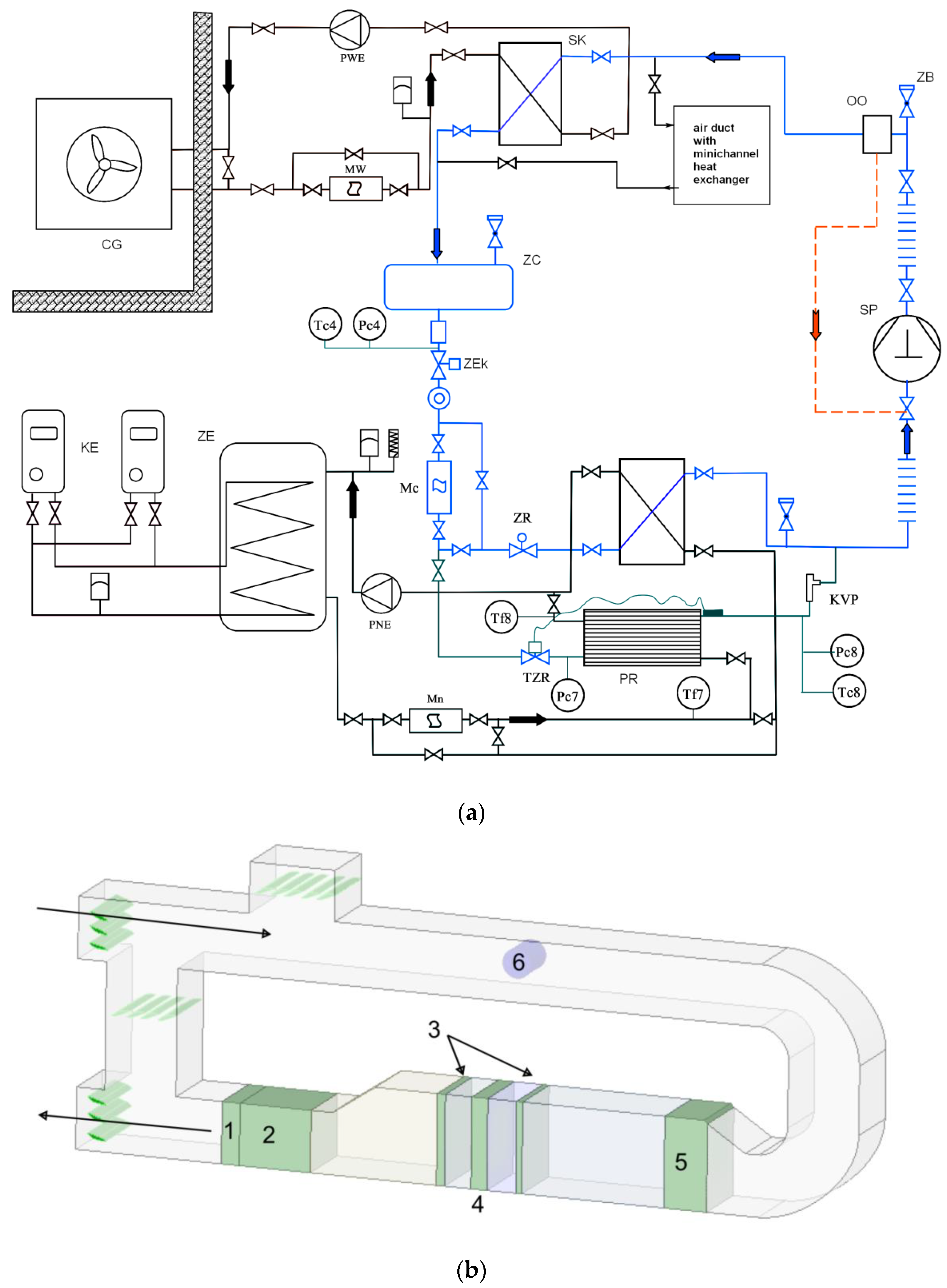



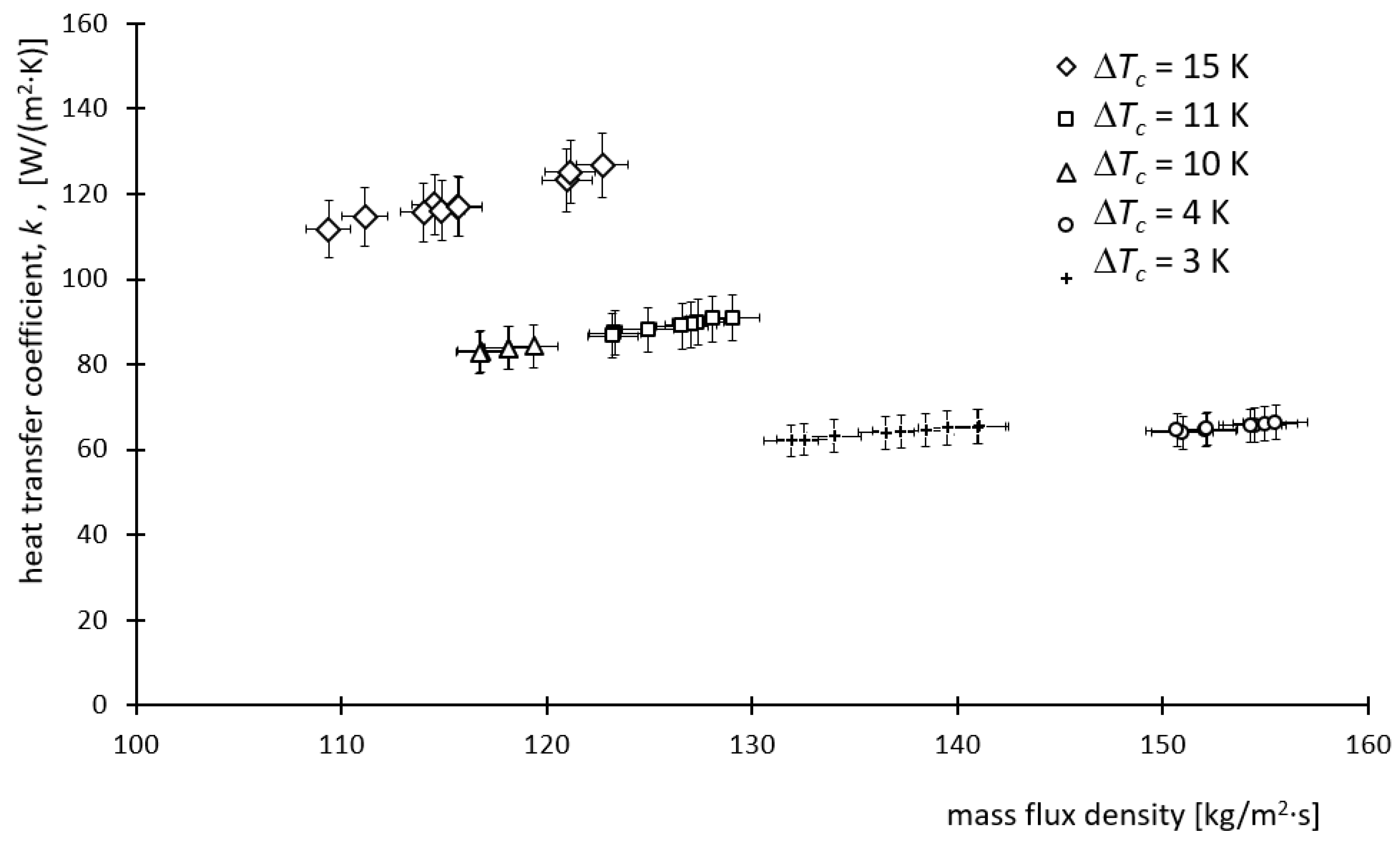

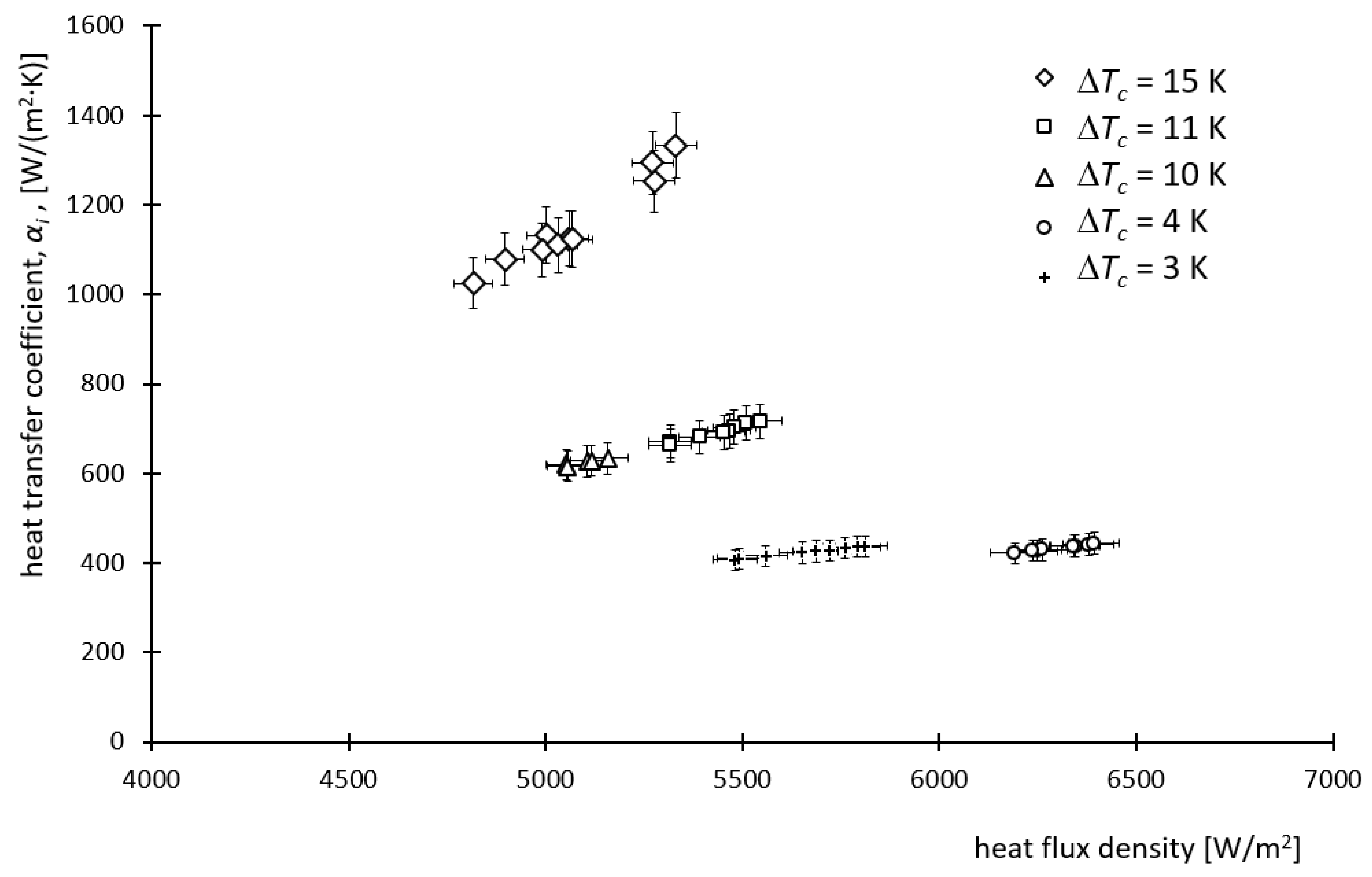
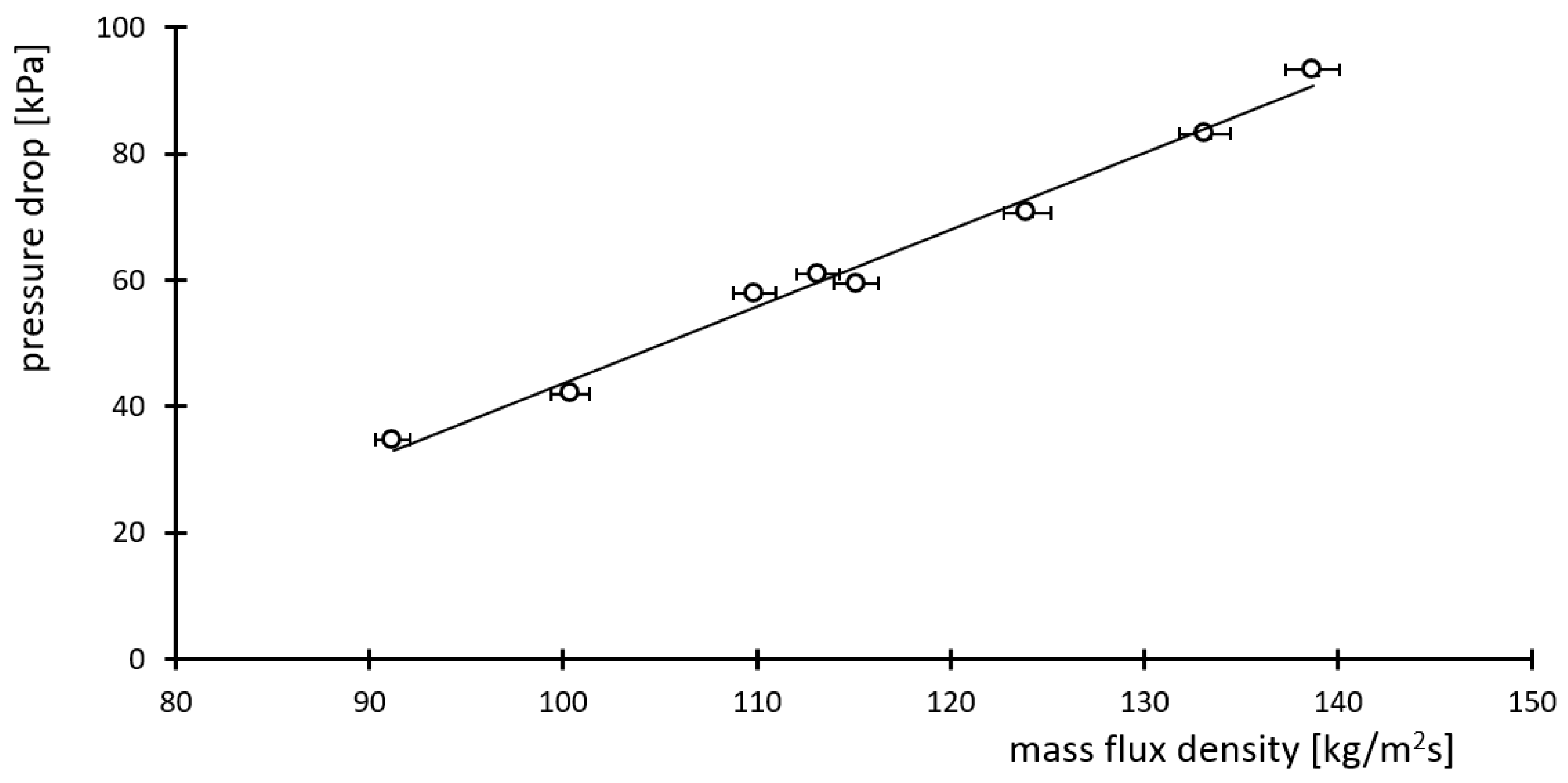
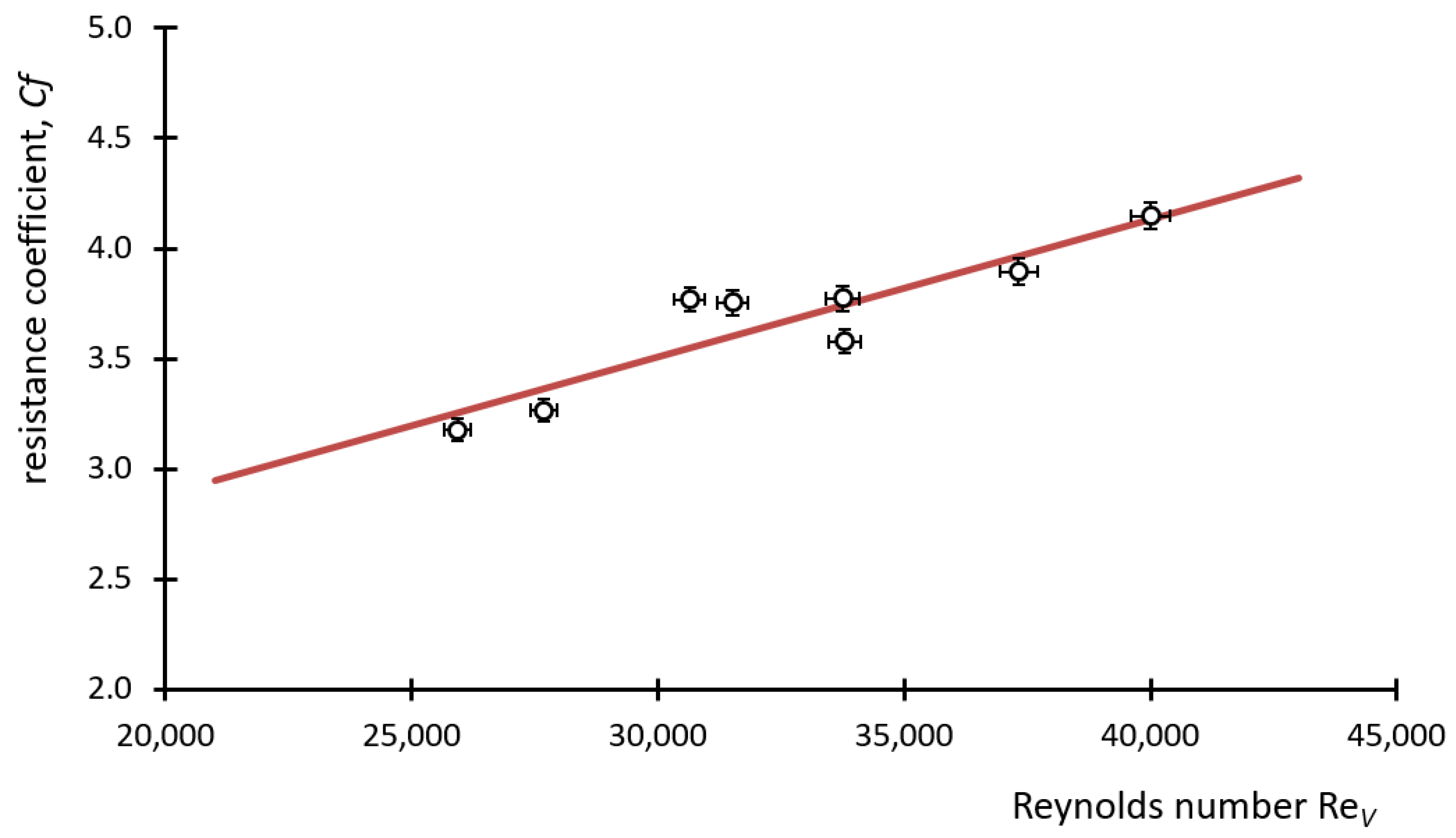
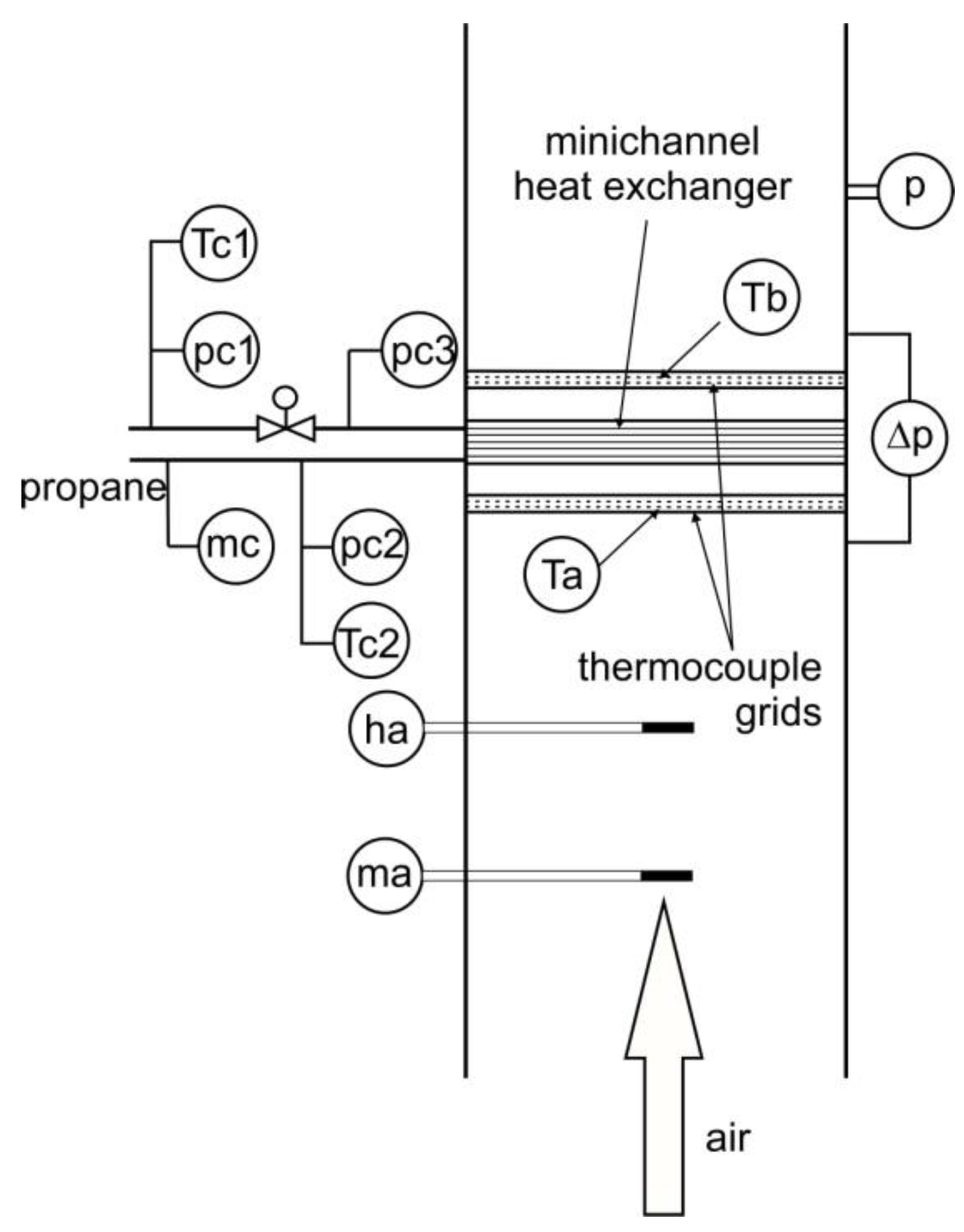

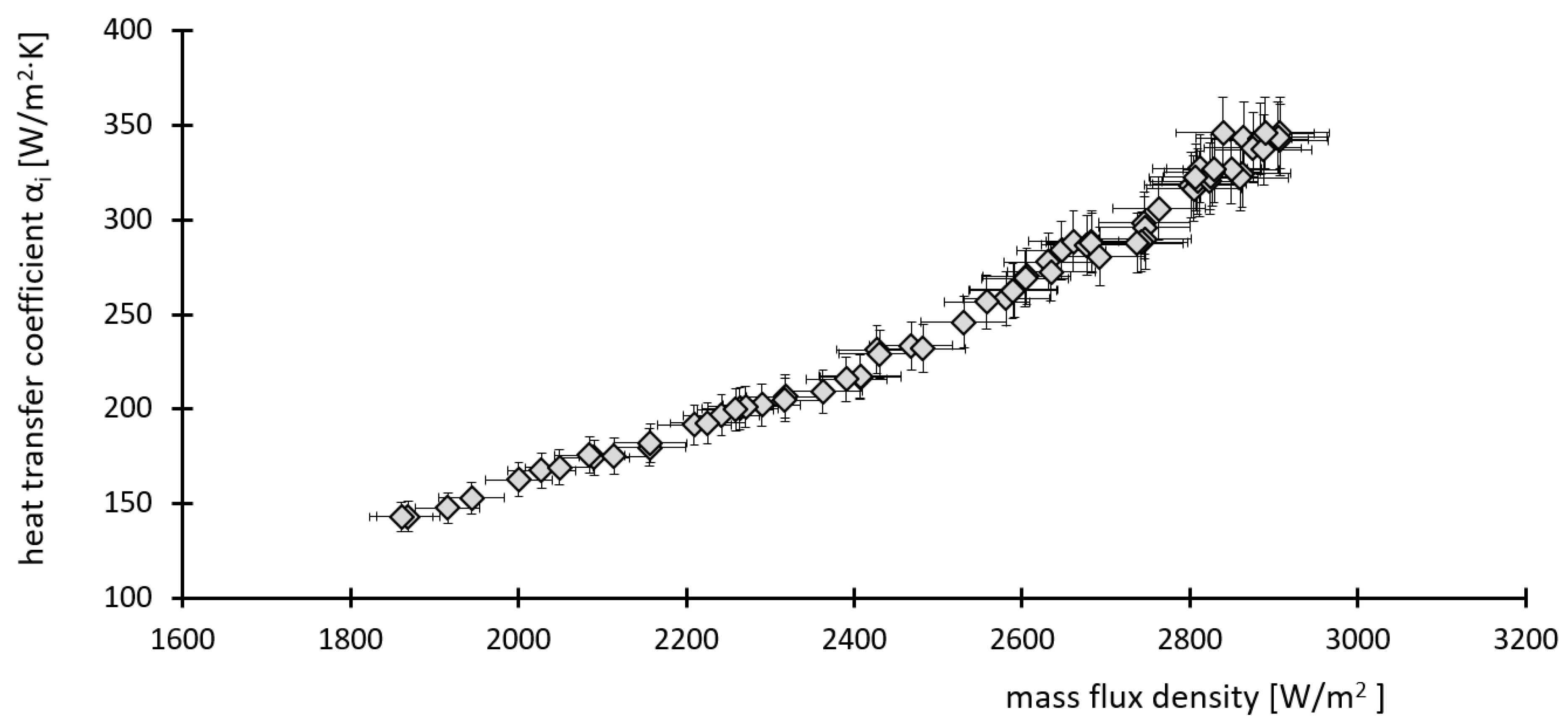
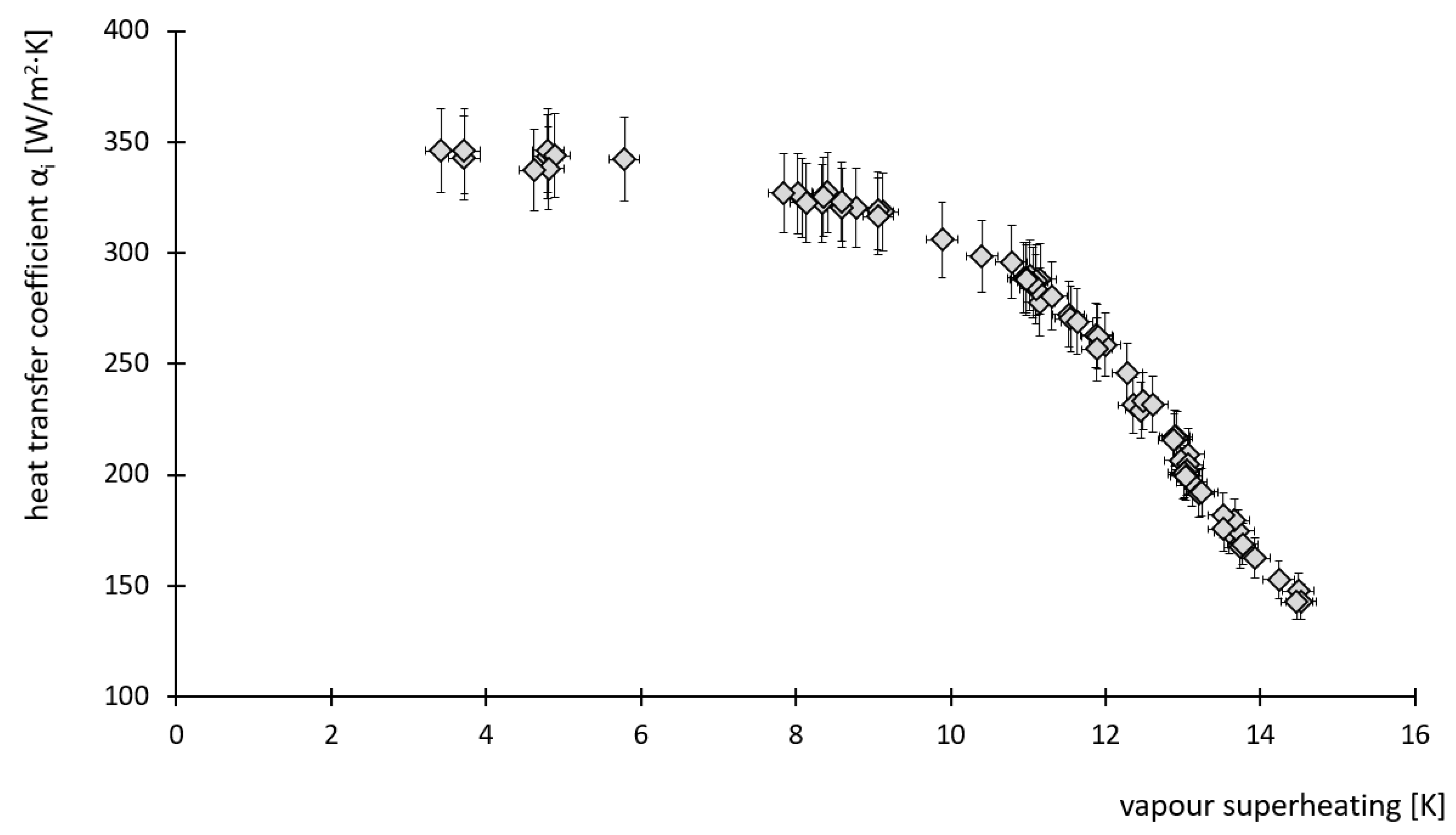
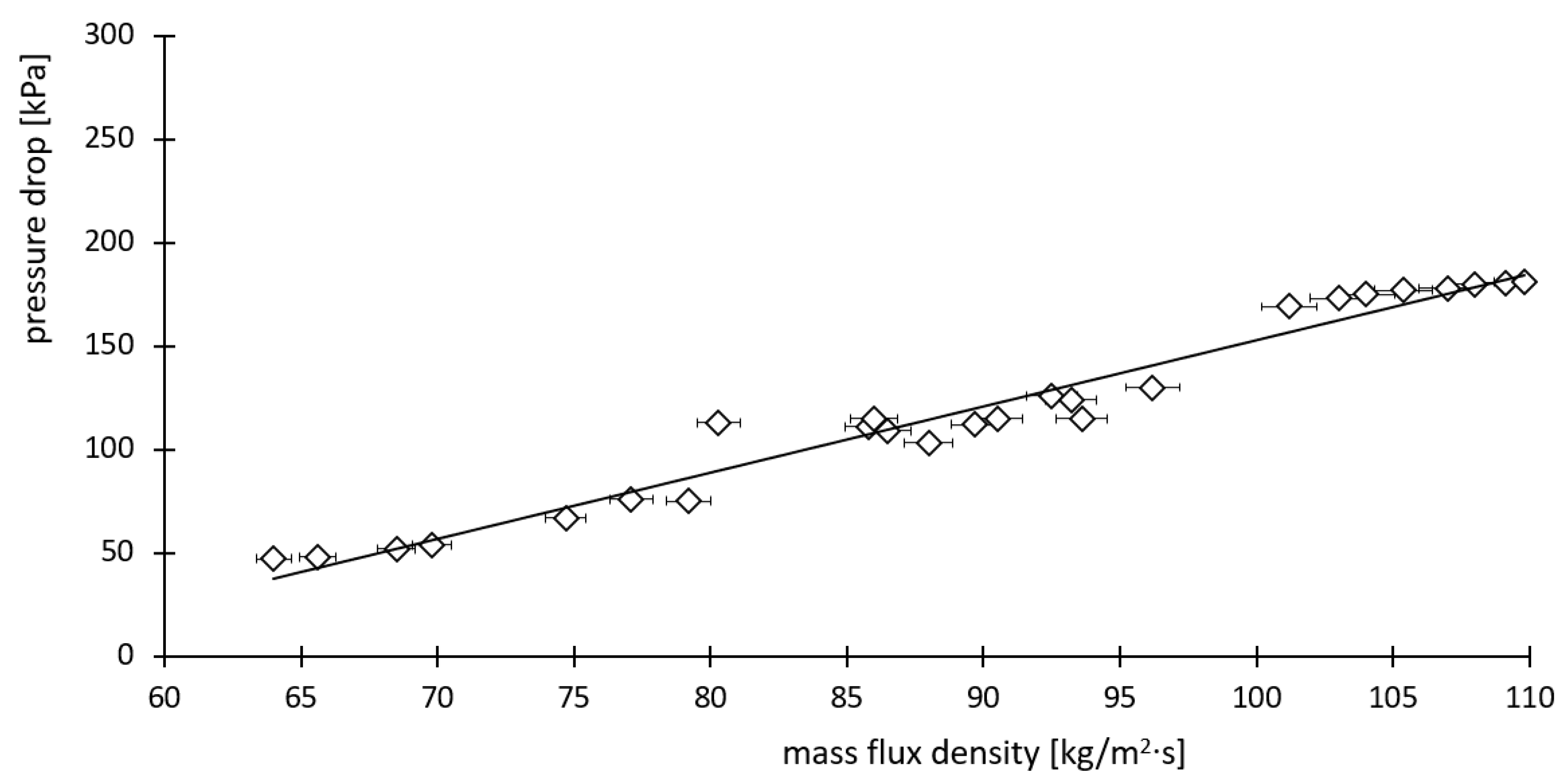
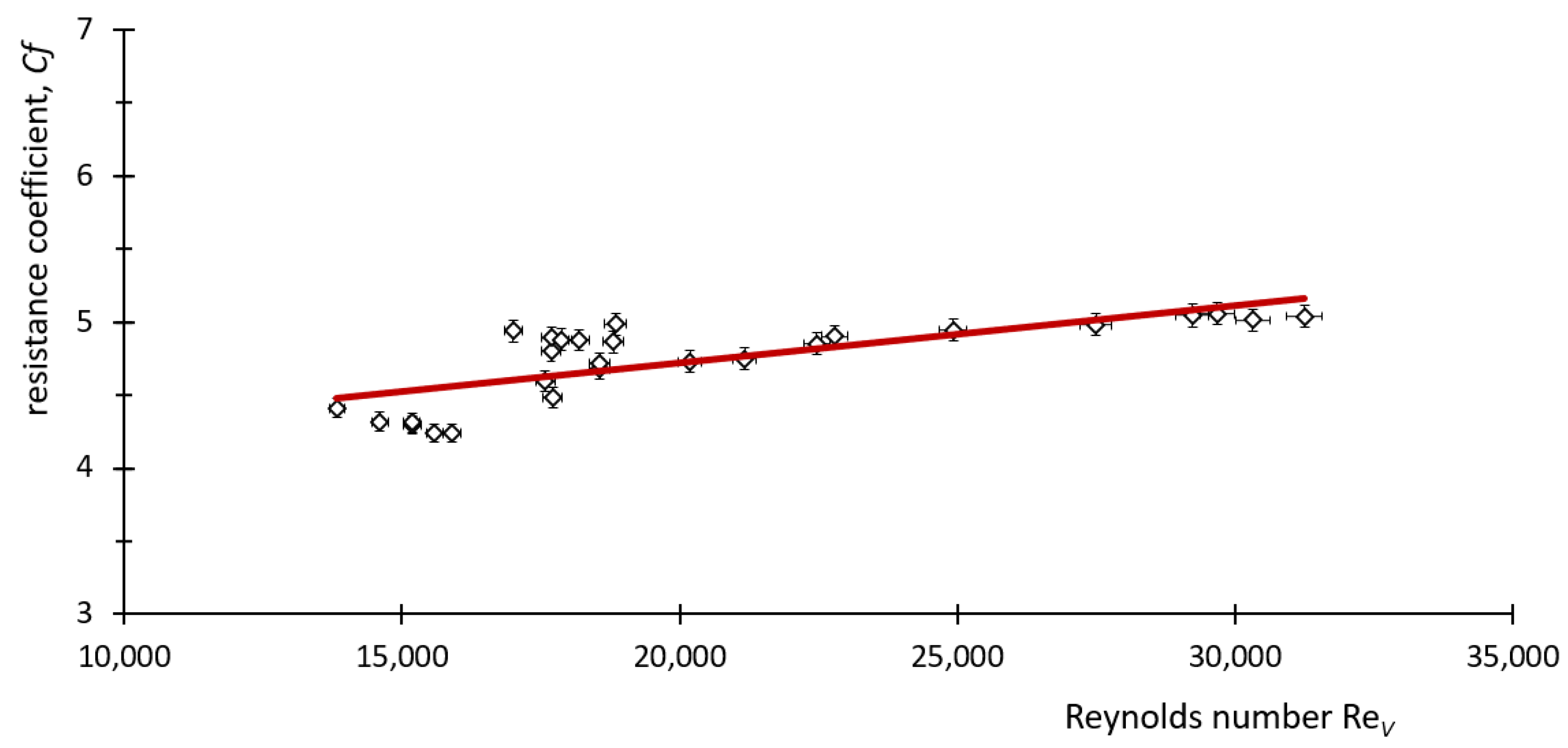
| Parameter | Value | Parameter | Value | Parameter | Value |
|---|---|---|---|---|---|
| Length/Height/Width | 800/855/25 mm | Air Side | Refrigerant Side | ||
| pipe diameter | 25/2/0.33 | inlet/outlet temperatures | 35.0 °C/41.8 °C | condensation pressure | 15.4 bar |
| nominal thermal capacity | 16.4 kW | volumetric flow rate | 2.1 m3/s | liquid subcooling | 8.0 K |
| volume | 6.7 dm3 | pressure drop | 49 Pa | mass flow rate | 180 kg/h |
| pressure drop | 7.3 kPa | ||||
| number of sections | 4 | ||||
| Inlet | Outlet | ||||||||||
|---|---|---|---|---|---|---|---|---|---|---|---|
| ti,1 | ti,2 | ti,3 | ti,4 | ti,5 | ti,1 | ti,2 | ti,3 | ti,4 | ti,5 | ||
| t1,j | 21.2 | 21.3 | 21.2 | 21.4 | 21.2 | t1,j | 32.7 | 29.8 | 29.8 | 29.8 | 28.1 |
| t2,j | 21.3 | 21.6 | 21.5 | 21.5 | 21.0 | t2,j | 32.2 | 29.7 | 29.7 | 29.5 | 28.4 |
| t3,j | 21.7 | 21.4 | 21.3 | 21.0 | 21.7 | t3,j | 28.2 | 29.0 | 29.0 | 29.1 | 28.5 |
| t4,j | 21.5 | 21.4 | 20.5 | 21.2 | 21.1 | t4,j | 26.6 | 26.9 | 27.8 | 28.2 | 27.6 |
| t5,j | 21.3 | 21.1 | 21.3 | 21.5 | 20.9 | t5,j | 24.1 | 24.4 | 24.4 | 25.3 | 25.6 |
| Inlet | Outlet | ||||||||||
|---|---|---|---|---|---|---|---|---|---|---|---|
| ti,1 | ti,2 | ti,3 | ti,4 | ti,5 | ti,1 | ti,2 | ti,3 | ti,4 | ti,5 | ||
| t1,j | 14.5 | 14.6 | 15.7 | 15.2 | 15.2 | t1,j | 12.1 | 14.7 | 10.6 | 10.6 | 12.1 |
| t2,j | 14.6 | 15.3 | 14.9 | 14.9 | 14.1 | t2,j | 7.6 | 14.5 | 8.7 | 8.0 | 11.5 |
| t3,j | 14.4 | 15.1 | 14.6 | 12.4 | 14.9 | t3,j | 8.6 | 14.7 | 8.3 | 12.3 | 10.5 |
| t4,j | 14.9 | 14.9 | 13.6 | 14.3 | 15.2 | t4,j | 8.4 | 13.9 | 8.1 | 13.1 | 9.7 |
| t5,j | 14.3 | 13.9 | 16.0 | 14.6 | 14.4 | t5,j | 8.4 | 9.5 | 11.1 | 12.3 | 12.2 |
Publisher’s Note: MDPI stays neutral with regard to jurisdictional claims in published maps and institutional affiliations. |
© 2022 by the authors. Licensee MDPI, Basel, Switzerland. This article is an open access article distributed under the terms and conditions of the Creative Commons Attribution (CC BY) license (https://creativecommons.org/licenses/by/4.0/).
Share and Cite
Butrymowicz, D.; Śmierciew, K.; Gagan, J.; Dudar, A.; Łukaszuk, M.; Zou, H.; Łapiński, A. Investigations of Performance of Mini-Channel Condensers and Evaporators for Propane. Sustainability 2022, 14, 14249. https://doi.org/10.3390/su142114249
Butrymowicz D, Śmierciew K, Gagan J, Dudar A, Łukaszuk M, Zou H, Łapiński A. Investigations of Performance of Mini-Channel Condensers and Evaporators for Propane. Sustainability. 2022; 14(21):14249. https://doi.org/10.3390/su142114249
Chicago/Turabian StyleButrymowicz, Dariusz, Kamil Śmierciew, Jerzy Gagan, Adam Dudar, Michał Łukaszuk, Huiming Zou, and Adam Łapiński. 2022. "Investigations of Performance of Mini-Channel Condensers and Evaporators for Propane" Sustainability 14, no. 21: 14249. https://doi.org/10.3390/su142114249
APA StyleButrymowicz, D., Śmierciew, K., Gagan, J., Dudar, A., Łukaszuk, M., Zou, H., & Łapiński, A. (2022). Investigations of Performance of Mini-Channel Condensers and Evaporators for Propane. Sustainability, 14(21), 14249. https://doi.org/10.3390/su142114249







